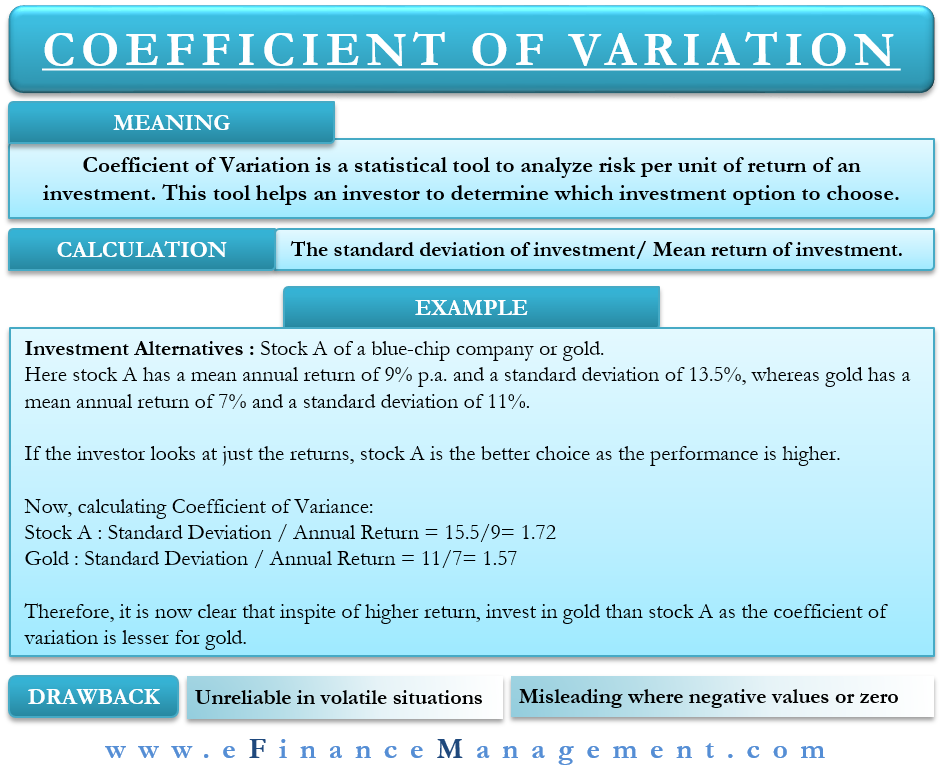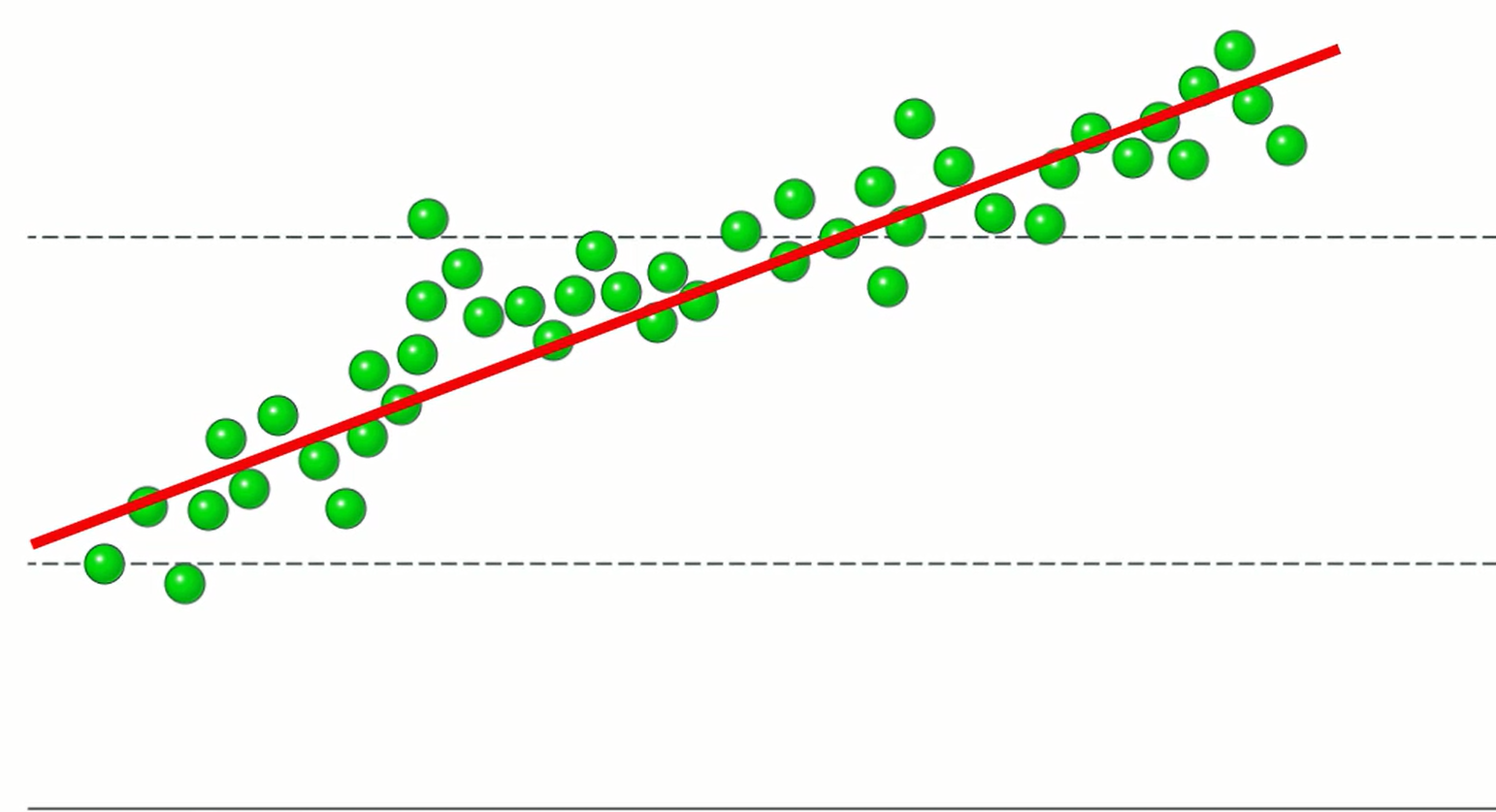Coefficient of Variation Is Best Described as
When one variable changes the other variables change in the same direction. Or we can say it measures the distribution of data points in accordance with the mean.

Coefficient Of Variation Formula The Concept Applications
Coefficient of Variation Volatility Expected Returns 100.

. The coefficient of variation COV is a measure of relative event dispersion thats equal to the ratio between the standard deviation and the mean. The average of the absolute differences between the values of the data set and the mean. To calculate the coefficient of variation in her potential stock investment Jamila inputs her volatility percentage of 7 and her expected return percentage of 13.
The metric is commonly used to compare the data dispersion between distinct series of data. A CV of 15 means the standard deviation is 15 times larger than the mean. It clearly only makes sense for the current as the mean potential will vary according to the reference electrode used.
CV 713 x 100. Greater than 10 are associated with unstable customer demand. This is an easy way to remember its formula it is simply the standard deviation relative to the mean.
The coefficient of variation is best described as _____. The difference between the maximum and minimum values The standard deviation expressed as a percent of the mean The average deviation about the mean. The coefficient of variation is an indicator of the relative scatter of the values and it was initially suggested that a large value would indicate localised corrosion.
Calculating the Standard Deviation Coefficient of Variation. It is the ratio of the standard deviation and mean of your data set. In other words it reflects how similar the measurements of two or more variables are across a dataset.
Depending on the context of the application you can make slight changes to this formula. Graphically this can be seen below. It falls between 0 and 1.
In simple terms the coefficient of variation is the ratio between the standard deviation and the mean. A CV of 1 means the standard deviation is equal to the mean. The coefficient of variation relative standard deviation is a statistical measure of the dispersion of data points around the mean.
Who are the experts. It is often expressed as a percentage and is defined as the ratio of the standard deviation. Suppose we have the following dataset.
Coefficient of variation Standard Deviation Mean 100. The larger standard deviation has a. It falls between -1 and 1.
Standard Deviation From a statistics standpoint the standard deviation of a data set is a measure of the. Coefficient of variation is defined as the ratio of standard deviation to the arithmetic mean. Simply put the coefficient of variation is the ratio between the standard deviation and the mean.
Divide the volatility and return first. In probability theory and statistics the coefficient of variation CV also known as relative standard deviation RSD is a standardized measure of dispersion of a probability distribution or frequency distribution. Another name for the term is relative standard deviation.
We review their content and use your feedback to keep the quality high. Question 10 3 pts The Coefficient of Variation is best described as The middle 50 of the values. Coefficient of variation gives a sense of relative variability as reported by the GraphPad Statistical software website.
Coefficient of variation CV is a measure of the dispersion of data points around the mean in a series. If we take the standard deviation of the customer demand and divide it by the average customer demand the resulting dimensionless number is called the coefficient of variation C v. In the modeling setting the CV is calculated as the ratio of the root mean squared error RMSE to the mean of.
Statistics and Probability questions and answers. For example if you want to calculate CV in financial research you can rewrite the formula as. It is a unit-free measure therefore making it easier to interpret.
An absolute measure of dispersion. Less than 02 are associated with stable customer demand and higher values ie. A relative measure of dispersion.
As per sample and population data type the formula for standard deviation may vary. The coefficient of variation is best described as. Analyzing a single variable and interpreting a model.
The Coefficient of Variation CV The last measure which we will introduce is the coefficient of variation. The standard formulation of the CV the ratio of the standard deviation to the mean applies in the single variable setting. A relative measure of dispersion B.
What is not a measure of central location. Coefficient of Variation CV Standard DeviationMean 100. The coefficient of variation is best described as.
Experts are tested by Chegg as specialists in their subject area. The coefficient of variation is the standard deviation divided by the mean. The higher the coefficient of variation the higher the standard deviation of a sample relative to the mean.
CoV also known as the relative standard deviation is a dimensionless measure of relative variability. A correlation coefficient is a number between -1 and 1 that tells you the strength and direction of a relationship between variables. S a m p l e S t a n d a r d D e v i a t i o n i 1 n X i X 2 n 1.
Unlike the standard deviation. It is equal to the standard deviation divided by the mean. The most widely used measure of central location.
What is an advantage of the correlation coefficient over the covariance. It can be expressed either as a fraction or a percent. Note that the two means are equal but the two standard deviations are different.
A CV of 05 means the standard deviation is half as large as the mean. Coefficient of Variation CV is a statistical measure that helps to measure the relative variability of a given data series. CV 5385 x 100.
A coefficient of variation CV can be calculated and interpreted in two different settings.

Statistics How To Calculate The Coefficient Of Variation Youtube


No comments for "Coefficient of Variation Is Best Described as"
Post a Comment